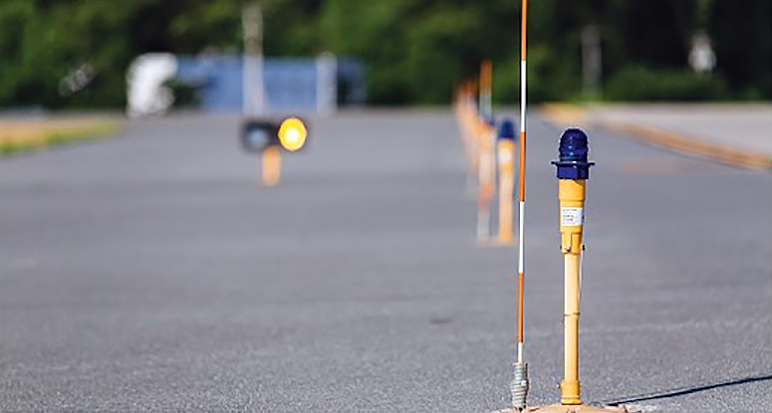Top Six Taxi Tips
How to Improve Your Ground Game
By Tom Hoffmann,
Managing Editor
FAA Safety Briefing
As a student pilot trainee at Long Island’s Mac Arthur Airport (KISP) in Islip, N.Y., my introduction to navigating around an airport was eye-opening to say the least. Besides reviewing my newly purchased Cessna 152 manual in the early days of my training, I was also instructed to become thoroughly familiar with the KISP airport diagram. The task seemed manageable, but on my first few flights I was more intent on listening for my call sign and straddling the yellow taxi line than trying to decipher the array of multi-colored lines, letters, and numbers all clamoring for my attention.
Thankfully my instructor did what good instructors do: he spent time helping me make sense of the airport’s sprawling expanse of taxiways, runways, and ramp areas. With four runways and air carrier jets taxiing to and fro, I quickly learned that KISP was no place to wind up somewhere you weren’t supposed to be.
Despite that initial intimidation, I soon felt comfortable taxiing my way safely around the airport and was glad I invested extra time to learn the ins and outs of airport sign language. However, as I have learned after several periods of inactivity, keeping yourself up to snuff on airport signage shouldn’t be limited to just your primary flight training days. With an average of three runway incursions (RI) each day in the United States, along with the occasional change to taxi clearances and airport markings, it’s always a good idea to regularly review airport surface operations and regard them with the same importance as any other phase of flight. With that in mind, I’ve assembled a list of tips that can help improve your ground game.
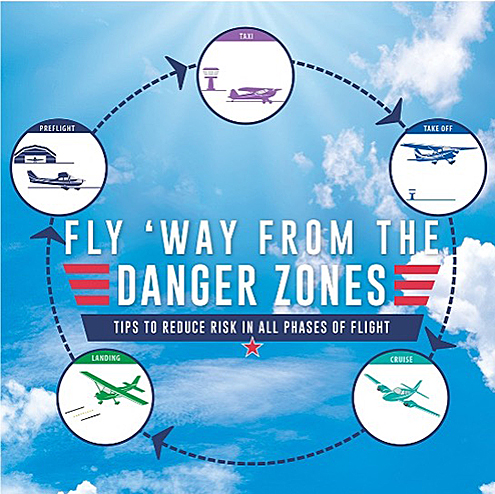
- Expect the Unexpected
With the excitement of the destination in your head, the chatter of anxious passengers, and the ubiquitous changes that crop up, it’s understandable that pilots can become distracted and sometimes complacent during taxi. Throw in an unexpected taxi clearance, some marginal weather, and/or a heavy amount of aircraft activity, and you’ve got a recipe for a potentially deadly runway incursion on your hands.
Take for example the following pilot deviation report, which shows just how close a disoriented Cessna came from being an accident statistic:
A Cessna 172 pilot was issued taxi instructions to Runway 35 via Taxiway Alpha which was read back correctly. The C172 taxied off the ramp, failed to make the turn southbound on Alpha, and taxied instead across Alpha. The Cessna then crossed the hold short line on Taxiway Delta for Runway 35 and came in conflict with another Cessna coming in for a touch and go on the same runway. In this case, the closest horizontal separation reported was less than 100 feet.
The good news is that by preparing (study the airport diagram before you taxi!), leveraging the technology at your disposal (moving map displays), and having a solid understanding of airport signage, you can significantly mitigate the risk in these types of situations — even at airports with more taxiways than letters in the alphabet. Although it may seem like there are an infinite number of differences between airports, you’ll find that markings, signage, and lights are similar and standardized, and used even more consistently than the road signs you might see on your drive to the airport. Don’t assume you know all there is to know about signage and markings. You’d be surprised to learn how a clear majority of RIs are caused by a simple mistake with the basics of airport navigation.
- Don’t Get Burned at Airport Hot Spots
An airport surface hot spot is a location on an airport movement area with a history or potential risk of collision or runway incursion where heightened attention by pilots and ground vehicle drivers is necessary. Hot spots are generally found in areas with confusing or complex geometry (e.g., an intersection with multiple runways and taxiways). It’s vital to check the airport diagram and know where the hot spots are before you go to any airport — even if you have been there before.
Thanks to recent efforts by the FAA’s Runway Safety Group, identifying and distinguishing different types of hot spots just became much easier with new standardized symbology. The FAA now uses three shapes with two distinct meanings: a circle or ellipse for ground movement hot spots and a cylinder for wrong surface hot spots.
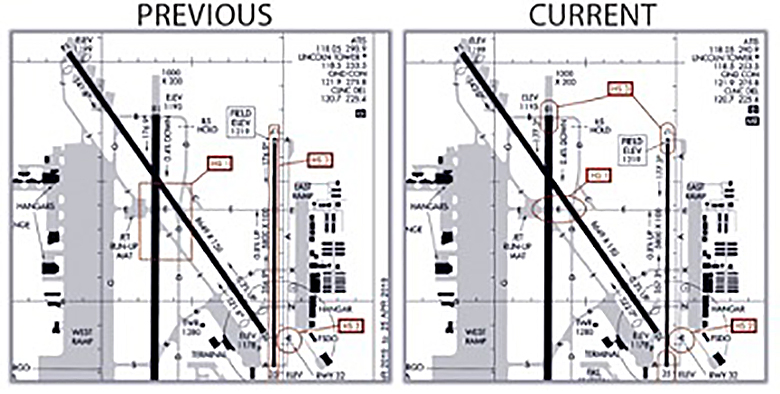
CAPTION: An example of the changes to Airport Hot Spots on the Airport Diagram chart. A circle or ellipse indicates ground movement hot spots, and a cylinder indicates wrong surface hot spots.
Watch this video for an overview on the hot spot changes.
Also check out the video series that covers seven airfield geometry configurations that could result in a runway incursion.
Click on the hamburger icon in the upper right to view all the videos in the playlist and select it to play here.
- Wrong Surface Events Happen More Often Than You Think
It can happen to the best of us. After a long taxi at a bustling and somewhat unfamiliar airport, it is not uncommon to find yourself at both a literal and figurative fork in the road before takeoff. “Is that my runway?” you mumble to yourself as you gaze at what appears to be a dizzying display of airfield location, instruction, and direction signs. It doesn’t help that you’re expecting an intersection takeoff and that you’ve got a long line of eager aircraft right behind you and looming in the pattern. Unfortunately, this type of scenario that leads to a wrong surface event is more common than you might think. In fiscal year 2021, there were 70 attempted wrong surface departures reported. A vast majority of these situations occurred with general aviation pilots during daytime visual meteorological conditions.
The risks associated with a wrong surface or wrong direction takeoff are serious. The surface you mistakenly use could be closed, under repair, or damaged, or it may not be long enough to use for a safe takeoff. You also run the risk of colliding with other aircraft or vehicles approved to operate on that surface, be it a runway or taxiway. Thankfully, there are several red flags that if caught in time, can help you avoid being on the wrong surface at the wrong time.
As we stated earlier, be aware of any complex geometry or hot spots at your airport. Pilots used to a single runway, non-towered environment can be in for a rude awakening at a larger airfield, with multiple taxiway and runway intersections. Be sure to also listen to ATIS for more than just wind and altimeter setting. You could be missing out on crucial construction notices, runway closures, or runway misalignment warnings.
Another easy way to avoid a wrong surface takeoff is to set the heading bug on your heading indicator to the assigned runway heading before you taxi and verify the aircraft is heading this direction when lined up on the runway. Use your magnetic compass to crosscheck the correct heading. Finally, practice active listening and eliminate all distractions in the cockpit. Don’t let expectation bias (what you think the taxi clearance will be) influence your actions.
For some good tips on avoiding a wrong surface takeoff, check out this From the Flight Deck video or view the scenarios at FAARunwaySafetySimulator.com.
- When in Doubt, Give ATC a Shout
While it might involve swallowing a bit of pride, if you are ever in doubt as to your position on the airport or your taxi clearance, don’t be afraid to stop where you are and ask the tower for help and/or progressive taxi instructions. And if you receive an instruction from ATC that you’re uncomfortable with or are unable to comply with, simply state “unable.” ATC can and will help you in both cases.
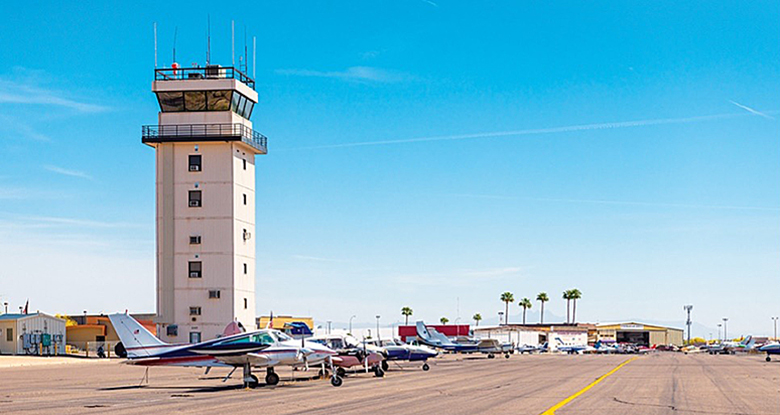
ATC can be an ally to avoid taxi incidents. When in doubt, ask.
- Don’t Cross the Line!
Literally, don’t cross the line. The hold short line that is — unless you’ve been specifically cleared to do so. Actually, there are several types of hold short position markings you may encounter while taxiing, all of which deserve careful attention. The first is a taxiway holding position marking, which is a single-dashed yellow line, usually found before the intersection of another taxiway. ATC may direct you to hold short here depending on the amount of traffic at your airport. The second is the holding position markings for Instrument Landing System (ILS) critical areas which resemble a horizontal ladder and span the width of the taxiway.
Then there is the runway holding position marking, which is by far one of the most critical markings on the airport. Sadly, however, it is also one of the most misunderstood and/or overlooked markings as indicated by their mention in hundreds of runway incursion reports each year.
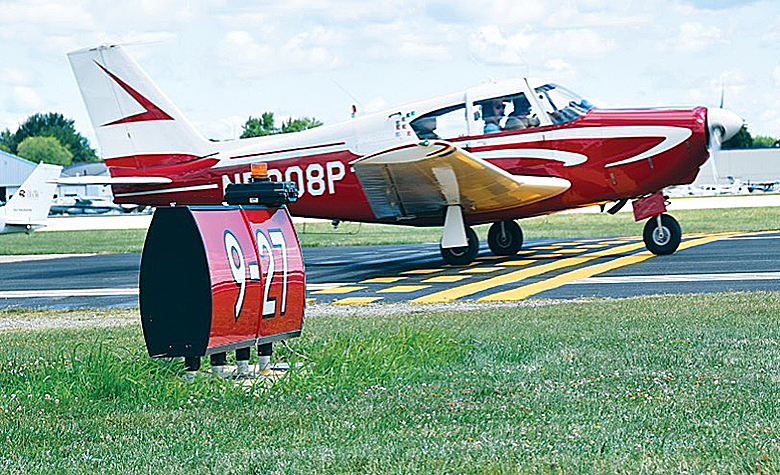
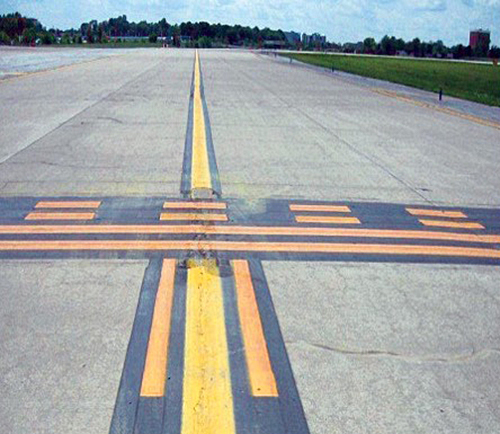
Better to hold short and ask if you are unsure of your clearance.
To review, a runway holding position marker is a combination of four yellow lines, two solid and two dashed (see photos above). The dashed lines face the runway while the solid lines are on the taxiway side. When approaching the runway, do not cross the runway holding position marking without ATC clearance at a controlled airport, or without making sure of adequate separation from other aircraft at uncontrolled airports. A helpful memory aid is to “stop for solid, dash through the dashes.”
To further alert pilots when approaching a runway holding position marking, all Part 139 airports now use enhanced taxiway centerlines. These enhanced taxiway lines are dashed lines on either side of the centerline 150 feet from the holding position marking. You may also see surface painted holding position markings with a red background and white inscription. These markings are designed to supplement the signs at a holding position and are usually found where the holding position on the taxiway is greater than 200 feet.
- Be Cool, Stay in School
There are tons of helpful resources available to pilots that can help you keep your taxi and airport navigation skills sharp. Here’s a breakdown of some of the ones you might find most useful.
Videos:
Without a doubt, the FAA’s From the Flight Deck video series has some of the most impactful and engaging runway safety content and is definitely worth viewing. The agency recently posted its 100th video of the series, which uses cockpit-mounted cameras to capture runway and taxiway footage of hot spots and safety-sensitive areas around the nation. Many of the videos also cover more general aviation safety challenges a pilot may encounter.
NOTE: A green airport icon indicates a current video. A blue airport icon indicates a video coming soon. This shows the latest “From the Flight Deck” video. Click on the hamburger icon in the upper right to view all the videos in the playlist and select it to play here.
Websites:
- The FAA’s Runway Safety page is the best place to start. It has links to the airport diagrams database, the list of hot spots, airport construction notices, and a host of runway safety resources.
- gov has several runway safety-related notices, listings of live seminars around the country, and online courses you can get WINGS credit for (e.g., Tarmac Tales — ALC-670)
- AOPA also offers a host of videos, courses and videos on its runway safety page here.
Handbooks/Guidance/Publications:
- The March/April 2021 issue of FAA Safety Briefing covered runway safety exclusively and provides a “road map” to the various tools, resources, and strategies airmen can use to steer clear of risk during the ramp-to-runway segment of their journey.
- Chapter 14 of the FAA’s Pilot’s Handbook of Aeronautical Knowledge covers runway safety and runway incursion avoidance techniques.
- A helpful list of runway safety reference documents, including flash cards and airport marking/signage documents.
- FAA SAFO 17010, Incorrect Airport Surface Approaches and Landings.
- NTSB Safety Alert 033, Landing at the Wrong Airport. (PDF download)
- AC 91-73B, Parts 91 and 135 Single Pilot, Flight School Procedures During Taxi Operations.
Tom Hoffmann is the managing editor of FAA Safety Briefing. He is a commercial pilot and holds an A&P certificate.
Reprinted with permission from FAA Safety Briefing. Visit the Flight Safety Briefing website: https://www.faa.gov/news/safety_briefing.




